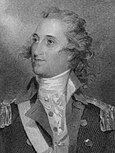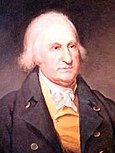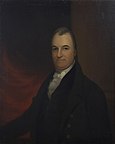List of Federalist Party presidential tickets
This is a list of Federalist Party candidates for the offices of President of the United States and Vice President of the United States.[1][2] Opponents who received over one percent of the popular vote or ran an official campaign that received Electoral College votes are listed. Offices held prior to Election Day are included, and those held on Election Day have an italicized end date.
List of Federalist tickets[]
1796, 1800[]
| Presidential nominee |
1796 (won), 1800 (lost) | Vice Presidential nominee | |
|---|---|---|---|
| John Adams of MA (1735–1826) 
|
|
|
Thomas Pinckney of SC (1750–1828) 
|
|
Charles Pinckney of SC (1746–1825) 
| ||
| Opponent(s) Thomas Jefferson (Democratic-Republican) |
|
Opponent(s) Aaron Burr (Democratic-Republican) | |
| |||
1804, 1808[]
| Presidential nominee |
1804 (lost), 1808 (lost) | Vice Presidential nominee | |
|---|---|---|---|
| Charles Pinckney of SC (1746–1825) 
|
|
|
Rufus King of NY (1755–1827) 
|
| Opponent(s) Thomas Jefferson (Democratic-Republican) |
|
Opponent(s) George Clinton (Democratic-Republican) | |
| |||
1812[]
| Presidential nominee |
1812 (lost) | Vice Presidential nominee | |
|---|---|---|---|
| DeWitt Clinton of NY[c] (1769–1828) 
|
|
|
Jared Ingersoll of PA (1749–1822) 
|
| Opponent(s) James Madison (Democratic-Republican) |
|
Opponent(s) Elbridge Gerry (Democratic-Republican) | |
1816[]
| Presidential nominee |
1816 (lost)[d] | Vice Presidential nominee | |
|---|---|---|---|
| Rufus King of NY[e] (1755–1827) 
|
|
|
John Howard of MD (1752–1827) 
|
| Opponent(s) James Monroe (Democratic-Republican) |
|
Opponent(s) Daniel Tompkins (Democratic-Republican) | |
1820[]
| Presidential nominee |
1820 (lost) | Vice Presidential nominee | |
|---|---|---|---|
| None[f] |
|
Richard Stockton of NJ (1764–1828) 
| |
| Opponent(s) James Monroe (Democratic-Republican) |
|
Opponent(s) Daniel Tompkins (Democratic-Republican) | |
Notes[]
- ^ Prior to the ratification of the Twelfth Amendment in 1804, each member of the Electoral College cast two votes, with no distinction made between votes for president and votes for vice president.[2] Federalist leaders agreed to support a ticket of John Adams and Thomas Pinckney, though it is unclear whether they formally nominated the ticket at a congressional nominating caucus.[3] Ultimately, Adams won the most electoral votes and became president. Because Democratic-Republican candidate Thomas Jefferson won more electoral votes than Pinckney, he was elected as vice president.[2]
- ^ Prior to the ratification of the Twelfth Amendment in 1804, each member of the Electoral College cast two votes, with no distinction made between votes for president and votes for vice president.[2] The Federalist congressional nominating caucus nominated a ticket of Adams and Charles C. Pinckney. Though the party did not officially nominate either candidate for president or vice president, most Federalists favored Adams for president and Pinckney for vice president.[4] Ultimately, Adams won 65 electoral votes and Pinckney won 64 electoral votes.[2]
- ^ Clinton was a Northern Democratic-Republican who challenged the incumbent Democratic-Republican president, James Madison, in the general election.[5] Clinton was nominated for president by a legislative caucus of New York Democratic-Republicans, and much of his support came from Democratic-Republicans dissatisfied with Madison's leadership in the War of 1812. The Federalist Party did not officially nominate Clinton, but most Federalist leaders tacitly supported Clinton's candidacy in hopes of defeating Madison.[6]
- ^ The Federalists did not nominate a ticket in 1816, though some Federalists were elected to serve as presidential electors. A majority of the Federalist electors cast their presidential vote for King and their vice presidential vote for Howard.[7]
- ^ Clinton was a Northern Democratic-Republican who challenged the incumbent Democratic-Republican president, James Madison, in the general election.[5] Clinton was nominated for president by a legislative caucus of New York Democratic-Republicans, and much of his support came from Democratic-Republicans dissatisfied with Madison's leadership in the War of 1812. The Federalist Party did not officially nominate Clinton, but most Federalist leaders tacitly supported Clinton's candidacy in hopes of defeating Madison.[8]
- ^ The Federalists did not nominate a presidential nominee in 1820.
Other candidates[]
In addition to the candidates listed above, other Federalists received electoral votes between 1796 and 1820. In the 1796 election, Oliver Ellsworth, John Jay, James Iredell, Samuel Johnston, and Charles Cotesworth Pinckney all received at least one electoral vote. Jay also received a single vote in the 1800 election. In the 1816 election, Robert Goodloe Harper, John Marshall, and James Ross all received electoral votes for vice president. In the 1820 election, Richard Stockton, Robert Goodloe Harper, Daniel Rodney, and Richard Rush all received at least one electoral vote for vice president.[1]
References[]
- ^ a b "Electoral College Box Scores 1789–1996". National Archives and Records Administration. Retrieved 16 September 2018.
- ^ a b c d e "United States Presidential Election Results". Dave Leip's Atlas of U.S. Presidential Elections. Retrieved 16 September 2018.
- ^ Morgan (1969), pp. 185–186
- ^ Morgan (1969), p. 186
- ^ a b Morgan (1969), pp. 191–193
- ^ Siry (1985), pp. 457–460
- ^ Deskins et al. (2010), pp. 65
- ^ Siry (1985), pp. 457–460
- ^ a b If not for a three electors dying prior to the Electoral College convening and not being replaced, Monroe would have received 234 votes (99.6%).
- ^ If not for a three electors dying prior to the Electoral College convening and not being replaced, Tompkins would have received 221 votes (94.0%).
Works cited[]
- Deskins, Donald Richard; Walton, Hanes; Puckett, Sherman (2010). Presidential Elections, 1789-2008: County, State, and National Mapping of Election Data. University of Michigan Press. ISBN 978-0472116973.
- Morgan, William G. (1969). "The Origin and Development of the Congressional Nominating Caucus". Proceedings of the American Philosophical Society. 113 (2): 184–196. JSTOR 985965.
- Siry, Steven Edwin (1985). "The Sectional Politics of "Practical Republicanism": De Witt Clinton's Presidential Bid, 1810–1812". Journal of the Early Republic. 5 (4): 441–462. JSTOR 3123061.
- Federalist Party
- Lists of candidates for President of the United States
